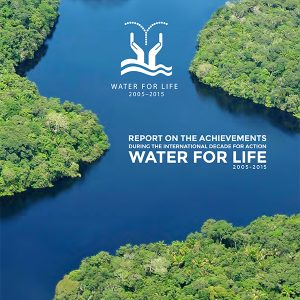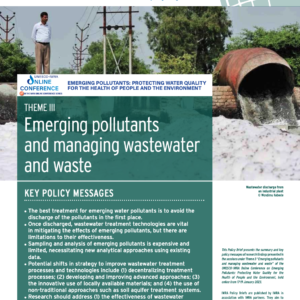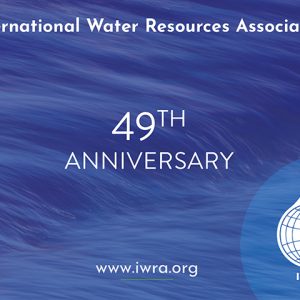Is Smart Water Management (SWM) Really A Smart Idea?
Selected contributions were considered for publication in the 2019 special issue on SWM.
Smart Water Management (SWM) refers to the application of new advances in Information and Communication Technology (ICT) to provide real-time, automated data that can be used in resolving water challenges and sometimes to enable corresponding innovations in management. When it provides a means of integrating information and communication, it can serve as a vehicle for integrated water resources management.
Smart Water Management was on the Association’s agenda for 2018 and continued to be during 2019, and possibly well into the future. In cooperation with the Korea Water Resources Corporation (K-water), we have compiled a set of case studies on Smart Water Management. IWRA prepared a Special Issue (SI) on the theme of SmartWater Management. The SI introduced our work on the topic so far but also took a step back and looked at SWM in a more comprehensive and, where applicable, critical way. We were particularly interested in exploring the relationship of SWM to institutional change (e.g., are new “smart” institutions necessary?), and how SWM can be implemented equitably to ensure that nobody is left behind.
Therefore, we posed the following Question of the Year 2019 to the IWRA Community:
- Is Smart Water Management Really A Smart Idea?
- If so, in what ways? If not, why not?
- Or is it smart in some ways and not in others?
- What could make it smarter (institutions, policy, other)?
As was the case with the Question of the Year 2018 on Water Quality, we invited the full IWRA membership as well as partners and supporters to join this discussion. Selected contributions received were considered for publication in the 2019 Special issue on SWM. Submitted answers included the following:
Please find below my contribution to your question, developed in https://blogs.adb.org/blog/get-smart-avoid-global-water-crisis.
Get smart to avoid a global water crisis: for smart systems to be successful, focus needs to be placed on infrastructure, operations and institutions.
Technology is a critical aspect of improving the availability and accessibility of clean water around the world. Many of us start our day by reaching for a glass of water, a ritual said to flush out toxins. For others, even before the crack of dawn, they are already waiting – desperately – for a pail of water, a daily ration to satisfy basic needs. Water is at once bountiful and scarce. Primary school has ingrained in us that our planet is about 70 percent water, and that through its cycle, water is eternally recurring. This makes it difficult for most of us to believe that water is now scarce and that a growing number of people are faced with the reality of zero water. Cape Town narrowly avoided this a year ago, and in Chennai today four of its main reservoirs are almost completely dry.
In developing countries in Asia, water utilities face three major issues: first, they have to manage diminishing resources and infrastructure that is largely spread out, often dilapidated and not well located and identified; second, they are working with low operational capacities, with a low incentive to perform; and third, they face a general lack of access to operational data and indicators to monitor progress.
Whereas rapid urbanization and climate change – two key drivers of water insecurity – are harder to control, water utilities are more manageable. The key is to transform these operators into modern and efficient organizations, valuing the people behind them and putting smart systems in place.
In recent years, the development of more affordable sensors, connected devices, and communication channels has revolutionized the quantity of technical data, essentially collecting from the ground information on water flows, pressure, and quality. Integrating this data from different sources on a platform has improved the management of infrastructure, energy, and manpower.
According to a 2016 Global Water Intelligence report, the market for control and monitoring solutions in the water sector worldwide is expected to reach $30.1 billion in 2021, with Asia and the Pacific having the biggest market share at $10.3 billion. No wonder automation or the greater Fourth Industrial Revolution is gaining traction—smart systems will only progress further and increase quality of life. Of course, smart systems are not magic. The goal is not to have or use fancy gadgetry but to optimize the operations of the water utilities and raise their service delivery so that the water network and infrastructure work for the people.
Infrastructure determines the performance of water systems, especially how the infrastructure is developed and maintained. More developed utilities have a comprehensive approach to locate, identify, qualify, and manage infrastructure assets, as well as assess the financial requirements to maintain it at a targeted performance. In Asia, though, this is often not the case.
Most utilities in the region require a systematic way to make decisions about repairing, rehabilitating or replacing aging assets, and to develop an effective strategy for long-term funding. Singapore – with its Public Utilities Board, the national water agency – is a global leader in this respect, having gone from a backwater island to a self-sustaining, highly advanced water-resilient country.
In the area of operations, a good approach is to begin with the end in mind. These heavy infrastructure projects should fully consider operations and maintenance aspects and capacity building from the design stage as this sets the foundation for the sustainability of the infrastructure and the efficiency of the service provided.
Utility transformation relies on incentivized management and operational staff, whose skills and capacity to operate systems should be well thought out. Not only are training sessions required, but a full reorganization of the utility around the performance and motivation of its staff.
Transforming water utilities requires not only improved infrastructure and operations, but also strong institutions that support and monitor the utility, both at the operations and regulation levels. Recent examples of cities facing water shortages show how this monitoring is important to ensure that utilities have necessary water resources and infrastructure to satisfy customer demand in the short and long term, and that tariffs are adjusted to allow recovery of costs.
Furthermore, these institutions should assess operators’ performance and monitor indicators from sources to examine what could impact their contractual arrangements, tariffs revisions, and incentive mechanisms. This holistic approach is the new trend to support governments and regulators to face water scarcity in cities and to better anticipate and manage a water crisis.
An independent supervision mechanism should also be in place to follow up achievements and enforce strong regulation in case of failure to comply. Smart systems can also further enhance business intelligence and detailed analysis for better control of contract performance.
These three focus areas – infrastructure, operations and institutions – together, made more formidable by smart systems, build a solid base from which we can help ensure water supply and equitable access. This is just the start but it could be coupled with water conservation measures, integrated resources management, and proactive governance.
This gives us a chance to avoid potential water crisis and conflict. At the end of the day, what we want is water for all, 24/7.
Updated: July 2019
Smart water management is a very good idea in the context of transboundary water management. However, such an idea poses many challenges on the regulatory and institutional levels as new information and communication technologies result in the emergence of new data that may change the positions of the different countries or affect the amount of water they may receive etc. In this situation, the existing regulatory frameworks in the context of transboundary water agreements which also pave the way towards the establishment of joint institutions do not include elements that take into consideration the new technologies and the potential changes that may occur despite the existence of data and information exchange provisions. This reality will affect the existing agreements and institutions as well as the future ones. Such a situation may be already witnessed for instance in the context of big data (I have been conducting research on this topic last year trying to understand the impact of new information and communication technologies on water management taking big data as a case study). In places like South Africa, they have established specific projects that deal with the impact of new technologies on the management of transboundary water resources be it surface water or groundwater. Still, from a legal perspective, there is still a gap in this regard.
Smart water management is a very good innovation that is very relevant in the World now. With current water trends which depict great variations in quantities of water available at different times, this is the way to go now. There is now a need to use water in more rational ways than ever before. All water supply designs should take into account this. Water management should be at the top of water supply so that the former informs the latter. We should think smart now in all activities we do regarding use of water resources.
I think that the concept of Smart Water Management (SWM) is a good idea, but not a “smart” one! In fact, utilising the up-to-date technologies, water management should always smart. In the other words, water management should always be equipped with smart techniques and constantly renewed. Therefore, there is no need for us to name it with an extra concept, “smart”. Actually, this expression implies some commercial expectations. So, I think that water management should not be intentionally used for commercial (wars) purposes.
SWM means different things in different contexts since it is not a precisely defined term. If it is broadly defined to mean the application of technologies to manage water resources then, like any tool, SWM works best where a long-term vision and purpose have been laid out in advance of investments in the tools themselves. With changes now occurring in the water cycle due to climate change, water management challenges extend beyond the traditional objectives of improving efficiencies to re-thinking water use and infrastructure design, as well as recognizing the co-dependence, with humans, of ecosystems on sufficient water supplies to sustain themselves. These challenges require on-going adaptive approaches and SWM can assist with numerous implementation and monitoring functions but it will not answer the core questions about priorities and values.
Population growth, modernization, and all other areas of development require that available resources are used efficiently. Being able to control and track water usage using technology is a good idea despite the fact it can not be applicable in most rural communities. It is obvious that in developed countries a lot of successes will be recorded with Smart water Management, unlike most developing countries. This concept, in the future, must meet global needs, and this can happen when it is understandable, cost-effective, easy-to-use, and sustainable.
In water management water organizations are facing growing challenges, including aging infrastructure, rising energy costs and growing populations. Smart water management helps solve these challenges through self-optimizing equipment and analytics that support proactive decisions. Smart Water Management (SWM) improve efficiency and reduce costs in water management. However, as populations start to grow, so does overall consumption, which increases the amount of water usage across the world. Smart Water Management (SWM) water management allows organizations to better manage public services.
Smart water management will certainly be the future of water management, although now it’s not feasible everywhere because of its high cost.
The intelligent management of water management is a principle that has not had enough forms and strategies that must be adequately transmitted in societies. First, because those who educate at primary and secondary levels lack the capacity of knowledge to transmit on this important principle.
Second, that in societies, those who administer and govern the water resource have not sufficiently conceived the ideology of the sustainability of water resource management.
SWM as a concept evolves in response to the rising need for collaborative information sharing and practices in water resources management. Automated responses towards increasing security and efficiency, while decreasing risk and uncertainty may be the addon that SWM brings to IWRM and the discuss on Water Resources Management. IWRM typically relies on principles of common pool resource management with relatively clear data-driven demand forecasts, where all players as user sectors, are given voice and apportioned user rights. But as a concept, IWRM is often criticised for both excess and lack of adherence to scientific principles, questioning its value outside academic discourse and often described as a consensus without practice.
The assertions that introducing real-time data and automation, will automatically translate to more efficient services, reliable water management, inclusive decision-making, and improved collaborative knowledge sharing still banks on the idealism that befell IWRM as a concept. How can SWM facilitate access to data especially in transboundary basins? How will AI-driven automated systems to bypass the need for self-sufficiency in water security to ensure equitable distribution with zero conflicting political interests? In addition to IWRM being regarded as ambitious in its objectives, idealistic in its agenda, and only used to secure funding, it is thought to have by now achieved measurable impacts the absence of which degrades it to a “hollow concept without merit.” It is therefore easily envisaged that as SWM inclines more towards socio-ecological consideration and institutional reforms in the planning and implementation process, it will likely open avenues for similar criticisms that waylaid IWRM and may die before its birth in the absence of which it will be fast labelled as biased.
The mention of water in IWRM drives a perception that it is single-faceted and non-holistic as it will be illogical to integrate a single resource. Despite an origin focused on a water-society interface, IWRM has struggled to evolve into a balanced account of human-environment relations and to include consideration of the entire ecosystem. This is what SWM as a concept must watch for as it carefully creates a niche within the confines of IWRM by first capitalising on its deficiencies to provide proven, tangible and trackable progress before being embedded within. Summarily, SWRM can be smart in her own way by first evolving as an independent provable concept that capitalises on real-time data and the need for automation in the water sector before being embedded within other existing concepts.
Smart Water Managament(SWM) is a solution to address water losses in a distribution network. According to Chadian Water Comapny,40% of the total volume of water produced per day is loss through leakages,pipe burst and illegal connection to the network system. This contributes to a great economic loss of the country and decreases the effeciency of water supply to the customers.However, The use of Information and Communication Technology(ICT) can help to improve the water service to the customers. If 40% of the water loss is expressed in terms of cash over a period of 40 years,it is enough to adopt an ICT to monitor the distribution network. For a sustainable water management,SWM is needed in all African cities with pipe born systems as Africa is faced with the issue of climate change,population growth and ever-increased water demand. Strict policy implementation with the support of institutions, a SWM can be made.
Smart Water Managament(SWM) is a solution to address water losses in a distribution network. According to Chadian Water Comapny,40% of the total volume of water produced per day is loss through leakages,pipe burst and illegal connection to the network system. This contributes to a great economic loss of the country and decreases the effeciency of water supply to the customers.However, The use of Information and Communication Technology(ICT) can help to improve the water service to the customers. If 40% of the water loss is expressed in terms of cash over a period of 40 years,it is enough to adopt an ICT to monitor the distribution network. For a sustainable water management,SWM is needed in all African cities with pipe born systems as Africa is faced with the issue of climate change,population growth and ever-increased water demand.
SWM is of course a good idea (which should improve efficiency and decrease costs) but as it happens for all the good ideas (see IWRM) the issue is a correct implementation.
Cases studies show that the application of new technologies may lead to a substantial improvement of a better water resource management as well as an increasing access to water and sanitation. However this technologies need a capacity to be correctly used: this capacity relies, on one hand on the ability to carry out an efficient management of data bases (collection, validation, treatment, easy access for the users), on the other hand on the capacity of the human resource to use correctly these advances rooms they get. It means that the implementation of SWM must include a strong part of training and capacity building. It is also important to develop an adapted communication to the people who will be concerned by the implementation of these new technologies in order to set up a socially acceptable system.
Smart is the way, and the think of the new era, smart management come to complement that idea, since a watershed real time analysis to a distribution smart system, we can keep up the I/O, the loss, then make better solutions, and manage better, we need technologies less expensive, easily applicable. We not really have a Perfect AI, smart an can analyze and make decisions, but we can facilitate the access to data, and adjust for better management. To make a management smarter we need better policies of preservation and concession for different water resources, with limits and based in studies, correlations, real data, to sustain the argument, to sensitize the different water users and to make simple decisions for many cases.
Smart Water Management is the good initiative at the present context. The water management education system will start from primary school onward. This system will be reach at the village people, farmers etc., The sustainable groundwater development and climate change related water management should be included in this scheme.
Technologically smart water management is a must to rationalise the system vrs. huge expenses of the project so as to ensure last mile connectivity with ease and control the huge UFW. With socially acceptable approach and fibre optics network, it is possible but we like space engineering, have to keep running relentlessly without glitch supported by robust cloud backup.
Smart water management is a great concept, but it has many facets and must be explained that way. For example, it can make systems more efficient (a good idea), but like other smart technologies, it has implications for privacy (a concern). Also, water systems have many social objectives and the jury is out about whether smart technologies help with those. It is my opinion that smart technologies can help with them, including helping with access and affordability of drinking water.




